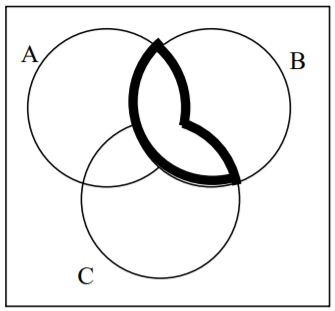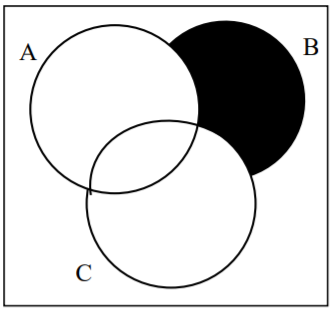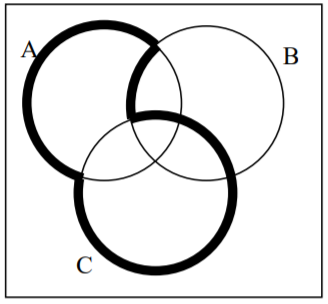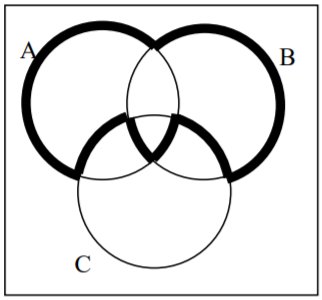3.5: Exercises
- Page ID
- 59942
1. List out the elements of the set “The letters of the word Mississippi.”
2. List out the elements of the set “Months of the year.”
3. Write a verbal description of the set {3, 6, 9}.
4. Write a verbal description of the set {a, e, i, o, u}.
5. Is {1, 3, 5} a subset of the set of odd integers?
6. Is {A, B, C} a subset of the set of letters of the alphabet?
For problems 7-12, consider the sets below, and indicate if each statement is true or false.
\(A\) = {1, 2, 3, 4, 5} \(B\) = {1, 3, 5} \(C\) = {4, 6} \(U\) = {numbers from 0 to 10}
7. \(3 ∊ B\)
8. \(5 ∊ C\)
9. \(B ⊂ A\)
10. \(C ⊂ A\)
11. \(C ⊂ B\)
12. \(C ⊂ D\)
Using the sets from above, and treating \(U\) as the Universal set, find each of the following:
13. \(A ⋃ B\)
14. \(A ⋃ C\)
15. \(A ⋂ C\)
16. \(B ⋂ C\)
17. \(A^c\)
18. \(B^c\)
Let D = {b, a, c, k}, E = {t, a, s, k}, F = {b, a, t, h}. Using these sets, find the following:
19. \(D^c ⋂ E\)
20. \(F^c ⋂ D\)
21. \((D ⋂ E) ⋃ F\)
22. \(D ⋂ (E ⋃ F)\)
23. \((F ⋂ E)^c ⋂ D\)
24. \((D ⋃ E)^c ⋂ F\)
Create a Venn diagram to illustrate each of the following:
25. \((F ⋂ E) ⋃ D\)
26. \((D ⋃ E)^c ⋂ F\)
27. \((F^c ⋂ E^c) ⋂ D\)
28. \((D ⋃ E) ⋃ F\)
Write an expression for the shaded region.
29.  30.
30.
31.  32.
32. 
Let A = {1, 2, 3, 4, 5} B = {1, 3, 5} C = {4, 6}. Find the cardinality of the given set.
33. \(\text{n}(A)\)
34. \(\text{n}(B)\)
35. \(\text{n}(A ⋃ C)\)
36. \(\text{n}(A ⋂ C)\)
The Venn diagram here shows the cardinality of each set. Use this in 37-40 to find the cardinality of the given set.

37. \(\text{n}(A ⋂ C)\)
38. \(\text{n}(B ⋃ C)\)
39. \(\text{n}(A ⋂ B ⋂ C^c)\)
40. \(\text{n}(A ⋂ B^c ⋂ C)\)
41. If \(\text{n}(G) = 20\), \(\text{n}(H) = 30\), \(\text{n}(G ⋂ H) = 5\), find \(\text{n}(G ⋃ H)\).
42. If \(\text{n}(G) = 5\), \(\text{n}(H) = 8\), \(\text{n}(G ⋂ H) = 4\), find \(\text{n}(G ⋃ H)\).
43. A survey was given asking whether they watch movies at home from Netflix, Redbox, or a video store. Use the results to determine how many people use Redbox.
- 52 only use Netflix
- 62 only use Redbox
- 24 only use a video store
- 16 use only a video store and Redbox
- 48 use only Netflix and Redbox
- 30 use only a video store and Netflix
- 10 use all three
- 25 use none of these
44. A survey asked buyers whether color, size, or brand influenced their choice of cell phone. The results are below. How many people were influenced by brand?
- 5 only said color
- 8 only said size
- 16 only said brand
- 20 said only color and size
- 42 said only color and brand
- 53 said only size and brand
- 102 said all three
- 20 said none of these
45. Use the given information to complete a Venn diagram, then determine: a) how many students have seen exactly one of these movies, and b) how many had seen only Star Wars.
- 18 had seen The Matrix (M)
- 24 had seen Star Wars (SW)
- 20 had seen Lord of the Rings (LotR)
- 10 had seen M and SW
- 14 had seen LotR and SW
- 12 had seen M and LotR
- 6 had seen all three
46. A survey asked people what alternative transportation modes they use. Using the data to complete a Venn diagram, then determine: a) what percent of people only ride the bus, and b) how many people don’t use any alternate transportation.
- 30% use the bus
- 20% ride a bicycle
- 25% walk
- 5% use the bus and ride a bicycle
- 10% ride a bicycle and walk
- 12% use the bus and walk
- 2% use all three


